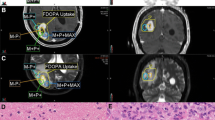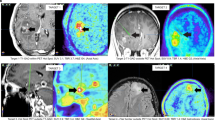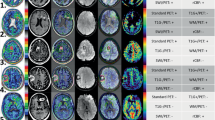Abstract
Purpose
We aimed to compare spatial extent of high-grade subregions detected with combined [18F]-dihydroxyphenylalanine (18F-DOPA) PET and MRI to the one provided by advanced multimodal MRI alone including Contrast-enhanced (CE) and Perfusion weighted imaging (PWI). Then, we compared the accuracy between imaging modalities, in a per biopsy analysis.
Methods
Participants with suspected diffuse glioma were prospectively included between June 2018 and September 2019. Volumes of high-grade subregions were delineated respectively on 18F-DOPA PET and MRI (CE and PWI). Up to three per-surgical neuronavigation-guided biopsies were performed per patient.
Results
Thirty-eight biopsy samples from sixteen participants were analyzed. Six participants (38%) had grade IV IDH wild-type glioblastoma, six (38%) had grade III IDH-mutated astrocytoma and four (24%) had grade II IDH-mutated gliomas. Three patients had intratumoral heterogeneity with coexisting high- and low-grade tumor subregions. High-grade volumes determined with combined 18F-DOPA PET/MRI (median of 1.7 [interquartile range (IQR) 0.0, 19.1] mL) were larger than with multimodal MRI alone (median 1.3 [IQR 0.0, 12.8] mL) with low overlap (median Dice’s coefficient 0.24 [IQR 0.08, 0.59]). Delineation volumes were substantially increased in five (31%) patients. In a per biopsy analysis, combined 18F-DOPA PET/MRI detected high-grade subregions with an accuracy of 58% compared to 42% (p = 0.03) with CE MRI alone and 50% (p = 0.25) using multimodal MRI (CE + PWI).
Conclusions
The addition of 18F-DOPA PET to multimodal MRI (CE and PWI) enlarged the delineation volumes and enhanced overall accuracy for detection of high-grade subregions. Thus, combining 18F-DOPA with advanced MRI may improve treatment planning in newly diagnosed gliomas.


Similar content being viewed by others
Data availability
Data and material are available from the corresponding author on reasonable request.
Code availability
Not applicable.
References
Ostrom QT, Bauchet L, Davis FG et al (2014) The epidemiology of glioma in adults: a “state of the science” review. Neuro Oncol 16:896–913. https://doi.org/10.1093/neuonc/nou087
Weller M, van den Bent M, Preusser M et al (2020) EANO guidelines on the diagnosis and treatment of diffuse gliomas of adulthood. Nat Rev Clin Oncol. https://doi.org/10.1038/s41571-020-00447-z
Almenawer SA, Badhiwala JH, Alhazzani W et al (2015) Biopsy versus partial versus gross total resection in older patients with high-grade glioma: a systematic review and meta-analysis. Neuro Oncol 17:868–881. https://doi.org/10.1093/neuonc/nou349
Aum DJ, Kim DH, Beaumont TL et al (2014) Molecular and cellular heterogeneity: the hallmark of glioblastoma. Neurosurg Focus 37:E11. https://doi.org/10.3171/2014.9.FOCUS14521
Scott JN, Brasher PMA, Sevick RJ et al (2002) How often are nonenhancing supratentorial gliomas malignant? A population study. Neurology 59:947–949. https://doi.org/10.1212/wnl.59.6.947
Castet F, Alanya E, Vidal N et al (2019) Contrast-enhancement in supratentorial low-grade gliomas: a classic prognostic factor in the molecular age. J Neurooncol 143:515–523. https://doi.org/10.1007/s11060-019-03183-2
Krivosheya D, Prabhu SS, Weinberg JS, Sawaya R (2016) Technical principles in glioma surgery and preoperative considerations. J Neurooncol 130:243–252. https://doi.org/10.1007/s11060-016-2171-4
Albert NL, Weller M, Suchorska B et al (2016) Response assessment in neuro-oncology working group and European association for neuro-oncology recommendations for the clinical use of PET imaging in gliomas. Neuro Oncol 18:1199–1208. https://doi.org/10.1093/neuonc/now058
Thust SC, Heiland S, Falini A et al (2018) Glioma imaging in Europe: a survey of 220 centres and recommendations for best clinical practice. Eur Radiol 28:3306–3317. https://doi.org/10.1007/s00330-018-5314-5
Delgado AF, Delgado AF (2017) Discrimination between glioma grades II and III using dynamic susceptibility perfusion MRI: a meta-analysis. AJNR Am J Neuroradiol 38:1348–1355. https://doi.org/10.3174/ajnr.A5218
Law I, Albert NL, Arbizu J et al (2019) Joint EANM/EANO/RANO practice guidelines/SNMMI procedure standards for imaging of gliomas using PET with radiolabelled amino acids and [18F]FDG: version 1.0. Eur J Nucl Med Mol Imaging 46:540–557. https://doi.org/10.1007/s00259-018-4207-9
Plotkin M, Blechschmidt C, Auf G et al (2010) Comparison of F-18 FET-PET with F-18 FDG-PET for biopsy planning of non-contrast-enhancing gliomas. Eur Radiol 20:2496–2502. https://doi.org/10.1007/s00330-010-1819-2
Wesseling P, Capper D (2018) WHO 2016 classification of gliomas. Neuropathol Appl Neurobiol 44:139–150. https://doi.org/10.1111/nan.12432
Patel CB, Fazzari E, Chakhoyan A et al (2018) 18F-FDOPA PET and MRI characteristics correlate with degree of malignancy and predict survival in treatment-naïve gliomas: a cross-sectional study. J Neurooncol 139:399–409. https://doi.org/10.1007/s11060-018-2877-6
Cicone F, Filss CP, Minniti G et al (2015) Volumetric assessment of recurrent or progressive gliomas: comparison between F-DOPA PET and perfusion-weighted MRI. Eur J Nucl Med Mol Imaging 42:905–915. https://doi.org/10.1007/s00259-015-3018-5
Langen K-J, Galldiks N, Hattingen E, Shah NJ (2017) Advances in neuro-oncology imaging. Nat Rev Neurol 13:279–289. https://doi.org/10.1038/nrneurol.2017.44
Kosztyla R, Chan EK, Hsu F et al (2013) High-grade glioma radiation therapy target volumes and patterns of failure obtained from magnetic resonance imaging and 18F-FDOPA positron emission tomography delineations from multiple observers. Int J Radiat Oncol Biol Phys 87:1100–1106. https://doi.org/10.1016/j.ijrobp.2013.09.008
Kazda T, Pafundi DH, Kraling A et al (2018) Dosimetric impact of amino acid positron emission tomography imaging for target delineation in radiation treatment planning for high-grade gliomas. Phys Imaging Radiat Oncol 6:94–100. https://doi.org/10.1016/j.phro.2018.06.004
Song S, Cheng Y, Ma J et al (2020) Simultaneous FET-PET and contrast-enhanced MRI based on hybrid PET/MR improves delineation of tumor spatial biodistribution in gliomas: a biopsy validation study. Eur J Nucl Med Mol Imaging. https://doi.org/10.1007/s00259-019-04656-2
Lohmann P, Stavrinou P, Lipke K et al (2019) FET PET reveals considerable spatial differences in tumour burden compared to conventional MRI in newly diagnosed glioblastoma. Eur J Nucl Med Mol Imaging 46:591–602. https://doi.org/10.1007/s00259-018-4188-8
Pauleit D, Floeth F, Hamacher K et al (2005) O-(2-[18F]fluoroethyl)-L-tyrosine PET combined with MRI improves the diagnostic assessment of cerebral gliomas. Brain 128:678–687. https://doi.org/10.1093/brain/awh399
Pafundi DH, Laack NN, Youland RS et al (2013) Biopsy validation of 18F-DOPA PET and biodistribution in gliomas for neurosurgical planning and radiotherapy target delineation: results of a prospective pilot study. Neuro Oncol 15:1058–1067. https://doi.org/10.1093/neuonc/not002
Pirotte BJM, Levivier M, Goldman S et al (2009) Positron emission tomography-guided volumetric resection of supratentorial high-grade gliomas: a survival analysis in 66 consecutive patients. Neurosurgery 64:471–481. https://doi.org/10.1227/01.NEU.0000338949.94496.85
John F, Bosnyák E, Robinette NL et al (2019) Multimodal imaging-defined subregions in newly diagnosed glioblastoma: impact on overall survival. Neuro Oncol 21:264–273. https://doi.org/10.1093/neuonc/noy169
Laack NN, Pafundi D, Anderson SK et al (2021) Initial results of a phase 2 trial of 18F-DOPA PET-guided dose-escalated radiation therapy for glioblastoma. Int J Radiat Oncol Biol Phys 110:1383–1395. https://doi.org/10.1016/j.ijrobp.2021.03.032
Filss CP, Galldiks N, Stoffels G et al (2014) Comparison of 18F-FET PET and perfusion-weighted MR imaging: a PET/MR imaging hybrid study in patients with brain tumors. J Nucl Med 55:540–545. https://doi.org/10.2967/jnumed.113.129007
Göttler J, Lukas M, Kluge A et al (2017) Intra-lesional spatial correlation of static and dynamic FET-PET parameters with MRI-based cerebral blood volume in patients with untreated glioma. Eur J Nucl Med Mol Imaging 44:392–397. https://doi.org/10.1007/s00259-016-3585-0
Tietze A, Boldsen JK, Mouridsen K et al (2015) Spatial distribution of malignant tissue in gliomas: correlations of 11C-L-methionine positron emission tomography and perfusion- and diffusion-weighted magnetic resonance imaging. Acta Radiol 56:1135–1144. https://doi.org/10.1177/0284185114550020
Tatekawa H, Hagiwara A, Yao J et al (2021) Voxelwise and patientwise correlation of 18F-FDOPA PET, relative cerebral blood volume, and apparent diffusion coefficient in treatment-naïve diffuse gliomas with different molecular subtypes. J Nucl Med 62(3):319–325. https://doi.org/10.2967/jnumed.120.247411
Schön S, Cabello J, Liesche-Starnecker F et al (2020) Imaging glioma biology: spatial comparison of amino acid PET, amide proton transfer, and perfusion-weighted MRI in newly diagnosed gliomas. Eur J Nucl Med Mol Imaging. https://doi.org/10.1007/s00259-019-04677-x
Verburg N, Koopman T, Yaqub MM et al (2019) Improved detection of diffuse glioma infiltration with imaging combinations: a diagnostic accuracy study. Neuro Oncol. https://doi.org/10.1093/neuonc/noz180
Floeth FW, Pauleit D, Wittsack H-J et al (2005) Multimodal metabolic imaging of cerebral gliomas: positron emission tomography with [18F]fluoroethyl-L-tyrosine and magnetic resonance spectroscopy. J Neurosurg 102:318–327. https://doi.org/10.3171/jns.2005.102.2.0318
Mauler J, Maudsley AA, Langen K-J et al (2018) Spatial relationship of glioma volume derived from 18F-FET PET and volumetric MR spectroscopy imaging: a hybrid PET/MRI study. J Nucl Med 59:603–609. https://doi.org/10.2967/jnumed.117.196709
Rausch I, Zitterl A, Berroterán-Infante N et al (2019) Dynamic [18F]FET-PET/MRI using standard MRI-based attenuation correction methods. Eur Radiol 29:4276–4285. https://doi.org/10.1007/s00330-018-5942-9
Girard A, Saint-Jalmes H, Chaboub N et al (2020) Optimization of time frame binning for FDOPA uptake quantification in glioma. PLoS ONE 15:e0232141. https://doi.org/10.1371/journal.pone.0232141
Schwarzenberg J, Czernin J, Cloughesy TF et al (2014) Treatment response evaluation using 18F-FDOPA PET in patients with recurrent malignant glioma on bevacizumab therapy. Clin Cancer Res 20:3550–3559. https://doi.org/10.1158/1078-0432.CCR-13-1440
Rose S, Fay M, Thomas P et al (2013) Correlation of MRI-derived apparent diffusion coefficients in newly diagnosed gliomas with [18F]-Fluoro-l-Dopa PET: what are we really measuring with minimum ADC? AJNR Am J Neuroradiol 34:758–764. https://doi.org/10.3174/ajnr.A3315
Somme F, Bender L, Namer IJ et al (2020) Usefulness of 18F-FDOPA PET for the management of primary brain tumors: a systematic review of the literature. Cancer Imaging 20:70. https://doi.org/10.1186/s40644-020-00348-5
Cicone F, Carideo L, Minniti G, Scopinaro F (2019) The mean striatal 18F-DOPA uptake is not a reliable cut-off threshold for biological tumour volume definition of glioma. Eur J Nucl Med Mol Imaging 46:1051–1053. https://doi.org/10.1007/s00259-019-4276-4
Chen W, Silverman DHS, Delaloye S et al (2006) 18F-FDOPA PET imaging of brain tumors: comparison study with 18F-FDG PET and evaluation of diagnostic accuracy. J Nucl Med 47(6):904–911
Kudo K, Uwano I, Hirai T et al (2017) Comparison of different post-processing algorithms for dynamic susceptibility contrast perfusion imaging of cerebral gliomas. Magn Reson Med Sci 16:129–136. https://doi.org/10.2463/mrms.mp.2016-0036
Abrigo JM, Fountain DM, Provenzale JM et al (2018) Magnetic resonance perfusion for differentiating low-grade from high-grade gliomas at first presentation. Cochrane Database Syst Rev. https://doi.org/10.1002/14651858.CD011551.pub2
Cuccarini V, Erbetta A, Farinotti M et al (2016) Advanced MRI may complement histological diagnosis of lower grade gliomas and help in predicting survival. J Neurooncol 126:279–288. https://doi.org/10.1007/s11060-015-1960-5
Acknowledgements
MRI data acquisition was performed at the Neurinfo MRI research facility (Rennes I University-Rennes University Hospital-INRIA-CNRS-Rennes Cancer Center). Neurinfo is also supported by Brittany Regional Council, Rennes Metropole, and GIS IBISA.
Funding
This study was fully self-funded by the Eugène Marquis Center, Rennes, France. A donation of 20.000€ from the Association for the Development of Hygiene and Epidemiology in Brittany (Association pour le Developpement de l’Hygiene et de l’Epidemiologie en Bretagne: A.D.H.E.B) to the Eugène Marquis Center was dedicated to this study.
Author information
Authors and Affiliations
Contributions
Conceptualization: AG, PLR, PN, FLJ. Methodology: AG, BCG, EB, FLJ. Formal analysis and investigation: AG, PLR, AM, BCN, DCC. Writing—original draft preparation: AG, PLR, XPN. Writing—review and editing: AD, FLJ. Funding acquisition: XPN, FLJ. Resources: DCC, EB, AD, XPN. Supervision: FLJ.
Corresponding author
Ethics declarations
Conflict of interest
The authors declare that they have no conflict of interest.
Ethical approval
This study was validated by a national research ethics committee “CCP Ile de France 1” under number CPPIDF1-2018-ND27-cat.2 on 17th April 2018. This study was performed in accordance with the ethical standards as laid down in the 1964 Declaration of Helsinki and its later amendments.
Consent to participate
All participants provided written and informed consent.
Consent for publication
All participants provided written and informed consent.
Additional information
Publisher's Note
Springer Nature remains neutral with regard to jurisdictional claims in published maps and institutional affiliations.
Supplementary Information
Below is the link to the electronic supplementary material.
Rights and permissions
About this article
Cite this article
Girard, A., Le Reste, PJ., Metais, A. et al. Combining 18F-DOPA PET and MRI with perfusion-weighted imaging improves delineation of high-grade subregions in enhancing and non-enhancing gliomas prior treatment: a biopsy-controlled study. J Neurooncol 155, 287–295 (2021). https://doi.org/10.1007/s11060-021-03873-w
Received:
Accepted:
Published:
Issue Date:
DOI: https://doi.org/10.1007/s11060-021-03873-w




